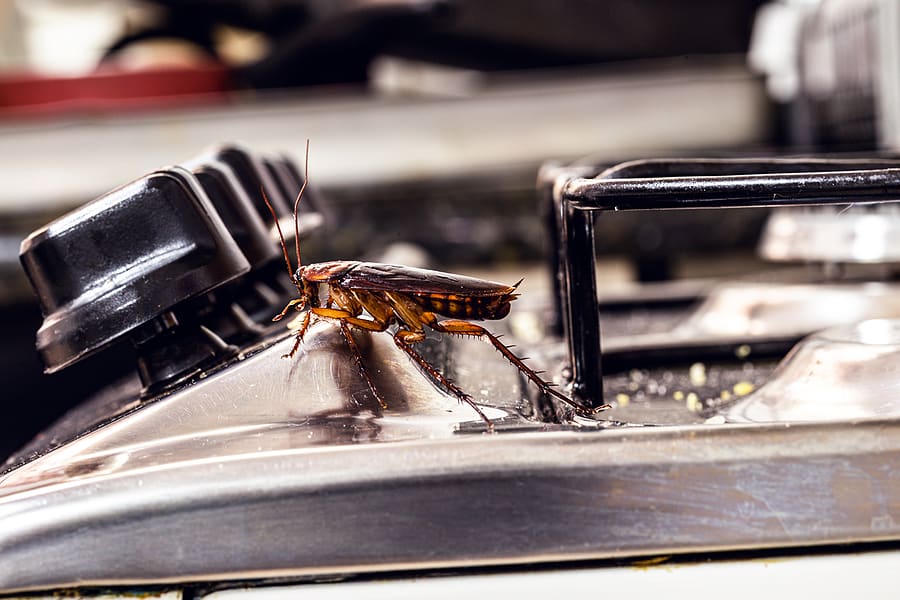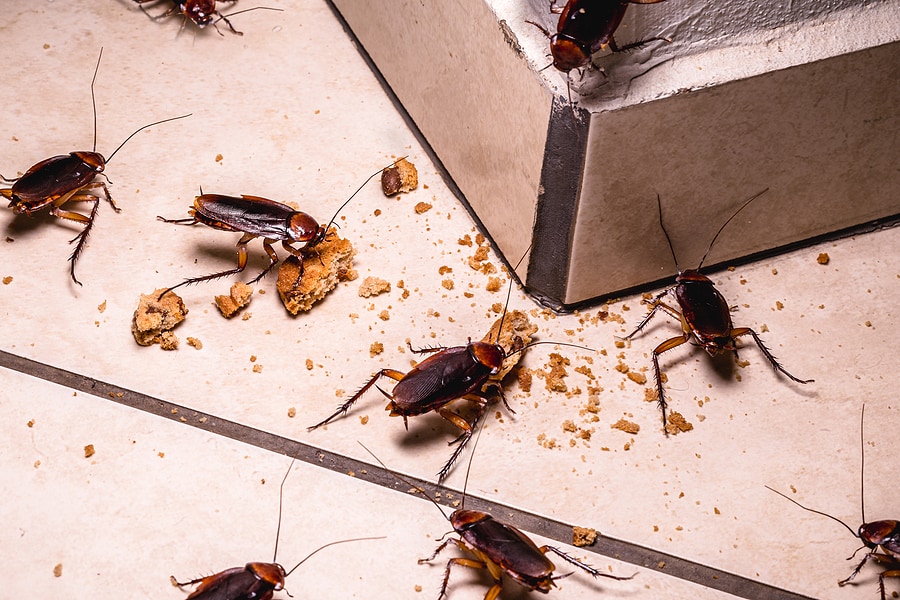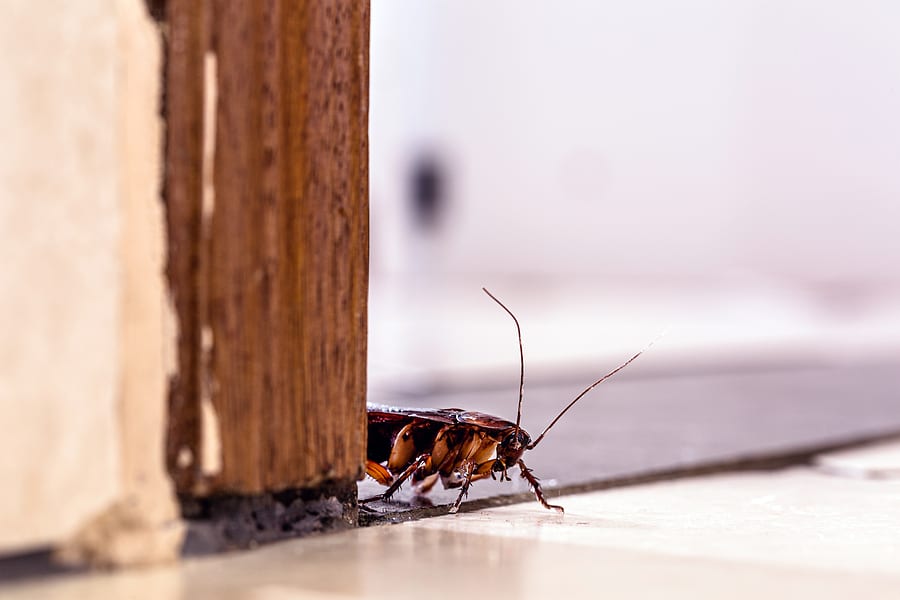READY TO GET STARTED?
REQUEST A FREE ESTIMATE
Fill out the form below or call (888) 466-7849 for a free, no-obligation estimate.

American cockroaches are a major household pest. Also known as water bugs and palmetto bugs, these pests are the largest of the cockroaches that infest homes. American cockroaches will make their way indoors in search of food and water. Their diet consists of leaves, wood particles, algae, fungi, small insects, food scraps, crumbs, and pet food. They can spread diseases and contaminate any surfaces they touch. They are also known to cause allergies and trigger asthma. These roaches will pick up germs on their legs and spread them to any surfaces they touch. They are known carriers of pathogens that cause diarrhea, cholera, leprosy, dysentery, plague, typhoid fever, and several viruses like poliomyelitis.
The first step in cockroach prevention is identifying the type of cockroach you are dealing with. Once that is determined, you can implement our favorite prevention tips to keep them from infesting your home.
American roaches are reddish-in color with a yellow band on the back of their heads. They range in size from 1-1/4″ to 2-1/8″ long, with some even reaching lengths of 3″. They have oval shaped bodies with 6 legs and a set of antennae. Despite their name, these cockroaches are found worldwide. Males and females both have wings and they can fly short distances. They can bite, but they rarely do. They normally live outdoors but will come inside looking for food and water. Outdoors they are commonly found in flower beds, trees, and under rocks. They are also commonly found in sewer systems. Inside the home they can be found in laundry rooms, kitchens, bathrooms, basements, and crawlspaces.
Learning how to spot signs of an roach infestation is critical to getting it under control. The most common sign is seeing the presence of cockroaches in your home. They will often flee to dark spaces when they’ve been discovered. They also leave behind droppings in the areas where they inhabit. These droppings have blunt ends and ridges on the sides and are often mistaken for mouse droppings. American cockroaches will also leave egg capsules behind. These are dark colored, about 8 mm long, and are often glued to surfaces near food sources. Finally, roaches emit a pheromone that gives off a musty odor. Smelling this in your home is another indication there is a cockroach infestation inside.
American roaches are highly resilient pests. They have evolved several adaptations over time that give them survival skills that make them difficult to eradicate. They can even survive up to a week without their heads! You can prevent cockroaches by:
If you have a problem with roaches in your home, contact your local pest control company who can identify what kind of roaches you have, how they are getting in, and the best treatment and ongoing prevention plan for your home.
Wildlife to Look Out for This Fall
Why Snake Control Is Important In The Fall

Cockroaches are common household pests that are found worldwide. While they don’t bite or cause structural damage to homes, they can be harmful to your health by contaminating food and other surfaces and triggering allergies and asthma in those affected. Roaches can get into the cleanest of homes in their quest for food, water, and shelter which they need to survive. Once inside, roaches will seek out warmth, moisture, and darkness, often being found in kitchens and bathrooms.
How do they get inside? Roaches have become very resourceful when it comes to getting into places. They can crawl through small holes or cracks in the exterior of buildings, flattening themselves into the smallest spaces. They will also squeeze through openings around doors and windows or sneak through when they’ve been left open too long. They will hitch a ride (or even lay their eggs) on bags, luggage, backpacks, used furniture, used appliances, packages, and even groceries that you bring unknowingly into your home. They can also come in through pipes or other holes in walls (especially shared walls like those in apartments).
If you have the makings of a cockroach infestation, try some of these cockroach prevention tips to help get them under control.
Identify and Prevent Brown Recluse in Your Tennessee Home
6 Signs of Subterranean Termites

Cockroaches are one of the most common household pests that homeowners have to deal with. These pests are resilient and are known to survive under the harshest conditions. So why do these pests seem so hard to get rid of? What are the best methods to eliminate them from making their way inside your home?
Cockroaches are built to be almost indestructible. Roaches have exoskeletons made up of overlapping plates connected by a stretchy membrane. This membrane is so flexible that it can allow them to fit through small cracks and crevices. Along with their stretchy membrane, they also have a thick outer layer that can protect them and shift when needed.
Since roaches can use their bodies to fit through small areas, they are great at surviving in harsh conditions. Cockroaches will find shelter to avoid harsh temperatures and other predatory pests that threaten them.
While cockroaches are durably built and sneaky, it doesn’t mean that they are impossible to keep from getting inside your home. Consider utilizing these roach prevention tips:

The last thing a homeowner wants to deal with is a pest infestation. One of the most common household pests is the cockroach, multiplying at a rapid rate and taking over in practically no time. The most common roaches found in households are American cockroaches, German cockroaches, and brown-banded cockroaches. Just because you see roaches in your home doesn’t mean you live in a dirty house; what attracts cockroaches may surprise you! Here are 5 common ways to attract cockroaches and how to prevent them.
Roaches thrive in dark, warm, moist, humid environments. Some of the most common sources of water in your home include leaky pipes under sinks and tubs, damp basements, AC units that leak, roof leaks, standing water, and piles of wet leaves. It is important to manage any moisture problems as soon as possible. Routinely inspect these areas of your home for leaks and fix them immediately. Consider enclosing your crawlspace to help control moisture under your home. Make sure gutters are functioning and downspouts are pointed away from foundations. Consider installing gutter guards to help prevent clogs.
Roaches will also come into your home in search of food and they will eat anything they can find. Roaches will forage in the garbage can for food scraps, grab any crumbs or food residue left on counters or floors, and can even chew through thin plastic or cardboard food containers. Make sure to clean your floors regularly by sweeping, mopping, and vacuuming. Wipe down countertops and stoves each night. Wash dishes nightly and empty the garbage regularly. Store food in plastic or glass containers rather than cardboard boxes.
One of the main things roaches eat are fibrous, organic materials found in paper and cardboard. Roaches love to feed on cardboard storage boxes that go undisturbed for long periods of time in attics, garages, and basements. Declutter as much as possible, getting rid of old boxes, newspapers, and magazines. Try to use plastic storage containers rather than cardboard boxes when possible.
Roaches don’t just get their food and water from humans. They are notorious for hijacking pet food and water bowls, especially at night, in their quest for survival. Try to feed your pets multiple times throughout the day rather than once at night. Don’t leave pet food or water bowls out overnight. Store pet food in airtight plastic containers rather than pet food bags. Clean up any spilled pet food and water, especially at night.
If your neighbors have a problem with cockroaches, there is a good chance you’ll end up with them, as well. This is especially true for apartments and other attached homes but can also occur with single family homes that are in close proximity to each other. Unfortunately, there isn’t much you can do to prevent your neighbors from getting an infestation; but you can take the above preventative steps and schedule routine pest control for your home to help keep them away.
Roaches can be extremely difficult to control and eliminate once they have established themselves in your home. If you have a problem with cockroaches or any other pests, contact a reliable pest control company who can identify the type of pest you are dealing with and provide you with an appropriate treatment and prevention plan.
Preventing a Mosquito Infestation
When Should You Start Fall Lawn Care?

Although cockroaches are considered a year-round pest, their populations swell in the summertime. Particularly in the southeast, roaches cause problems for both residential and commercial properties during these hot summer months. Cockroaches are hardy pests that are highly adaptable to a variety of conditions. They particularly thrive in warm, humid environments, which are readily available in the hot, muggy summer heat. Infestations are more likely in the summertime because this increase in temperature spurs them to feed and reproduce at a much faster rate. When the temperature gets too hot, even roaches that usually stay outdoors will make their way into your home or business in search of food, water, and shelter.
How can you prevent a cockroach infestation this summer? Check out these tips to prevent cockroaches from taking over your home.
Roaches will come indoors in search of food and water. Eliminating their food source is one way to discourage them from coming into your home. Don’t leave dirty dishes in the sink overnight; wash them and put them away after each meal. Clean up any crumbs or spills immediately. Wipe up any grease from the stovetop and other appliances. Seal food, including pet food, in airtight containers. Mop and vacuum on a regular basis. Don’t leave pet food or water out overnight. Take out the garbage before going to bed. Use garbage cans with tight fitting lids. Wipe out the trashcan regularly. Make sure to check behind cabinets and appliances for spills/crumbs. Roaches like these areas because of the warmth the appliances give off combined with the likelihood of spilled food.
Roaches hide out during the day so they will seek out dark, protected areas to hole up in until nightfall. Declutter your home and get rid of anything they can use for shelter. Roaches also love to breed in cardboard and newspaper. Recycle any old newspapers and get rid of unused cardboard boxes. Try to use plastic storage containers rather than cardboard boxes if possible.
Roaches are very creative when it comes to finding ways into your home. A good rule of thumb is if you can see daylight around a door or window, roaches can get in. Inspect at least once a year around windows and doors, along foundations and the roof, attic and crawlspace vents, and around holes used for electric, gas, and plumbing lines. Seal any cracks and holes you find. Use caulk to seal smaller holes, steel wool or foam for larger holes, and fine wire mesh on chimneys and attic vents.
Roaches (along with many other pests) are attracted to moisture because they need water to survive. Regularly inspect your home for any leaking faucets, sinks, or pipes and check refrigerators and appliances to make sure they aren’t producing excess moisture. Get any known leaks or plumbing issues fixed immediately.
Prevention can only get you so far when it comes to keeping roaches out. Nothing eliminates a pest as well as professional service. If you suspect you have a roach infestation, contact a pest control company who can thoroughly inspect your home to help identify which type of cockroach you are dealing with, help identify any potential areas where they are getting in, provide you with the most up-to-date elimination and control methods, and help you with a prevention plan going forward.
What Do Swarming Termites Mean?
How To Help Your Lawn During Late Summer